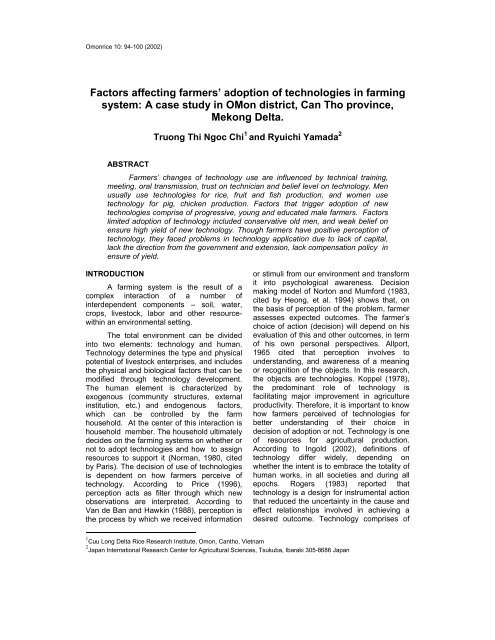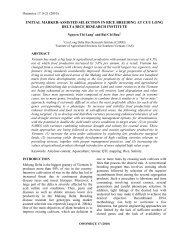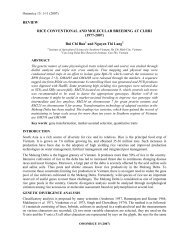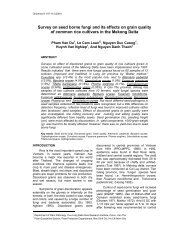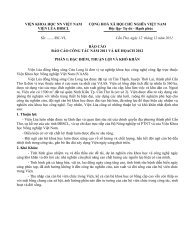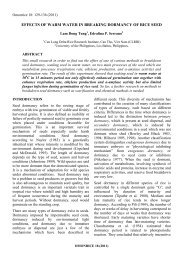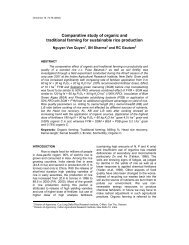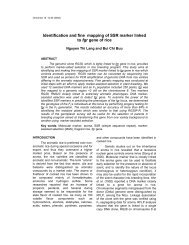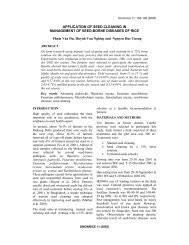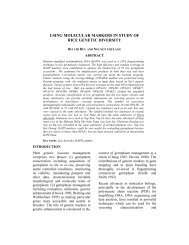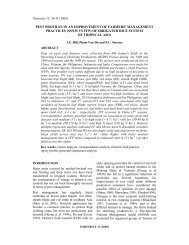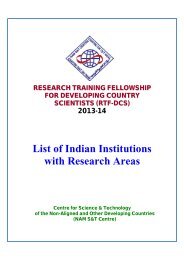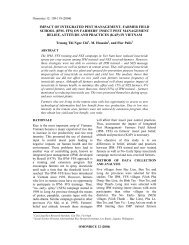Factors affecting farmers' adoption of technologies in farming system ...
Factors affecting farmers' adoption of technologies in farming system ...
Factors affecting farmers' adoption of technologies in farming system ...
Create successful ePaper yourself
Turn your PDF publications into a flip-book with our unique Google optimized e-Paper software.
Omonrice 10: 94-100 (2002)<strong>Factors</strong> <strong>affect<strong>in</strong>g</strong> farmers’ <strong>adoption</strong> <strong>of</strong> <strong>technologies</strong> <strong>in</strong> farm<strong>in</strong>g<strong>system</strong>: A case study <strong>in</strong> OMon district, Can Tho prov<strong>in</strong>ce,Mekong Delta.Truong Thi Ngoc Chi 1 and Ryuichi Yamada 2ABSTRACTFarmers’ changes <strong>of</strong> technology use are <strong>in</strong>fluenced by technical tra<strong>in</strong><strong>in</strong>g,meet<strong>in</strong>g, oral transmission, trust on technician and belief level on technology. Menusually use <strong>technologies</strong> for rice, fruit and fish production, and women usetechnology for pig, chicken production. <strong>Factors</strong> that trigger <strong>adoption</strong> <strong>of</strong> new<strong>technologies</strong> comprise <strong>of</strong> progressive, young and educated male farmers. <strong>Factors</strong>limited <strong>adoption</strong> <strong>of</strong> technology <strong>in</strong>cluded conservative old men, and weak belief onensure high yield <strong>of</strong> new technology. Though farmers have positive perception <strong>of</strong>technology, they faced problems <strong>in</strong> technology application due to lack <strong>of</strong> capital,lack the direction from the government and extension, lack compensation policy <strong>in</strong>ensure <strong>of</strong> yield.INTRODUCTIONA farm<strong>in</strong>g <strong>system</strong> is the result <strong>of</strong> acomplex <strong>in</strong>teraction <strong>of</strong> a number <strong>of</strong><strong>in</strong>terdependent components – soil, water,crops, livestock, labor and other resourcewith<strong>in</strong>an environmental sett<strong>in</strong>g.The total environment can be divided<strong>in</strong>to two elements: technology and human.Technology determ<strong>in</strong>es the type and physicalpotential <strong>of</strong> livestock enterprises, and <strong>in</strong>cludesthe physical and biological factors that can bemodified through technology development.The human element is characterized byexogenous (community structures, external<strong>in</strong>stitution, etc.) and endogenous factors,which can be controlled by the farmhousehold. At the center <strong>of</strong> this <strong>in</strong>teraction ishousehold member. The household ultimatelydecides on the farm<strong>in</strong>g <strong>system</strong>s on whether ornot to adopt <strong>technologies</strong> and how to assignresources to support it (Norman, 1980, citedby Paris). The decision <strong>of</strong> use <strong>of</strong> <strong>technologies</strong>is dependent on how farmers perceive <strong>of</strong>technology. Accord<strong>in</strong>g to Price (1996),perception acts as filter through which newobservations are <strong>in</strong>terpreted. Accord<strong>in</strong>g toVan de Ban and Hawk<strong>in</strong> (1988), perception isthe process by which we received <strong>in</strong>formationor stimuli from our environment and transformit <strong>in</strong>to psychological awareness. Decisionmak<strong>in</strong>g model <strong>of</strong> Norton and Mumford (1983,cited by Heong, et al. 1994) shows that, onthe basis <strong>of</strong> perception <strong>of</strong> the problem, farmerassesses expected outcomes. The farmer’schoice <strong>of</strong> action (decision) will depend on hisevaluation <strong>of</strong> this and other outcomes, <strong>in</strong> term<strong>of</strong> his own personal perspectives. Allport,1965 cited that perception <strong>in</strong>volves tounderstand<strong>in</strong>g, and awareness <strong>of</strong> a mean<strong>in</strong>gor recognition <strong>of</strong> the objects. In this research,the objects are <strong>technologies</strong>. Koppel (1978),the predom<strong>in</strong>ant role <strong>of</strong> technology isfacilitat<strong>in</strong>g major improvement <strong>in</strong> agricultureproductivity. Therefore, it is important to knowhow farmers perceived <strong>of</strong> <strong>technologies</strong> forbetter understand<strong>in</strong>g <strong>of</strong> their choice <strong>in</strong>decision <strong>of</strong> <strong>adoption</strong> or not. Technology is one<strong>of</strong> resources for agricultural production.Accord<strong>in</strong>g to Ingold (2002), def<strong>in</strong>itions <strong>of</strong>technology differ widely, depend<strong>in</strong>g onwhether the <strong>in</strong>tent is to embrace the totality <strong>of</strong>human works, <strong>in</strong> all societies and dur<strong>in</strong>g allepochs. Rogers (1983) reported thattechnology is a design for <strong>in</strong>strumental actionthat reduced the uncerta<strong>in</strong>ty <strong>in</strong> the cause andeffect relationships <strong>in</strong>volved <strong>in</strong> achiev<strong>in</strong>g adesired outcome. Technology comprises <strong>of</strong>1 Cuu Long Delta Rice Research Institute, Omon, Cantho, Vietnam2 Japan International Research Center for Agricultural Sciences, Tsukuba, Ibaraki 305-8686 Japan
<strong>Factors</strong> <strong>affect<strong>in</strong>g</strong> farmers’ <strong>adoption</strong> <strong>of</strong> <strong>technologies</strong> <strong>in</strong> farm<strong>in</strong>g <strong>system</strong> … 95two components, hardware and s<strong>of</strong>t ware.The hardware consists <strong>of</strong> physical tool thatembodies technology. The s<strong>of</strong>tware consists<strong>of</strong> <strong>in</strong>formation base for the tool. In Mumford’sclassification (1946), “technology–as–objects”encompasses the entire range <strong>of</strong> fabricateditems <strong>in</strong>tended for some use or other,<strong>in</strong>clud<strong>in</strong>g tools, utensils, utilities, apparatusand mach<strong>in</strong>es. Mitcham (1978), “technology–as–process”, <strong>in</strong>cludes most importantly theactivities we commonly denote as mak<strong>in</strong>g andus<strong>in</strong>g. The key element here is that <strong>of</strong> skilldef<strong>in</strong>ed as ‘pr<strong>of</strong>iciency <strong>in</strong> the use <strong>of</strong> artefact’.Ingold (2002) dist<strong>in</strong>guished technique fromtechnology. Technique refers to skills,regarded as capability <strong>of</strong> particular humansubjects, and technology means a corpus <strong>of</strong>generalized, objective knowledge, <strong>in</strong>s<strong>of</strong>ar as itis capable <strong>of</strong> practical application.Technology can be reached farmersthrough technology transfer. Technologytransfer refers to the general process <strong>of</strong>mov<strong>in</strong>g <strong>in</strong>formation and skills from <strong>in</strong>formationor knowledge ‘generators’ such as researchlaboratories and universities to clients such asfarmers (Valera et al. 1987).The outcome <strong>of</strong> new technologytransfer is the farmers’ <strong>adoption</strong> and br<strong>in</strong>g<strong>in</strong>gthis <strong>in</strong>to practice and further diffusion to other<strong>in</strong>dividuals <strong>in</strong> the community.Regard<strong>in</strong>g to <strong>adoption</strong>, farmerssometimes discover problems <strong>in</strong> putt<strong>in</strong>grecommendation <strong>in</strong>to practice, the extent <strong>of</strong><strong>adoption</strong>, adjustment or rejection depends on<strong>farmers'</strong> behavior (Valera et al. 1987). Mosher(1987, cited by Cruz, 1978) def<strong>in</strong>ed that<strong>adoption</strong> <strong>of</strong> an <strong>in</strong>novation is the process bywhich a particular farmer is exposed to,considers, and f<strong>in</strong>ally rejects or practices aparticular <strong>in</strong>novation. The <strong>in</strong>novation decisionmodel by Rogers (1983) shows the processthrough which an <strong>in</strong>dividual (or other decisionmak<strong>in</strong>g unit) passes from first knowledge <strong>of</strong>an <strong>in</strong>novation to form<strong>in</strong>g an attitude towardsthe <strong>in</strong>novation, to a decision to adopt or reject,to implement <strong>of</strong> the new idea, and toconfirmation <strong>of</strong> this decision.Diffusion is the process by which an<strong>in</strong>novation is communicated through certa<strong>in</strong>channels overtime among the members <strong>of</strong> asocial <strong>system</strong> (Rogers, 1983). When newideas are <strong>in</strong>vented, they are diffused andadopted or rejected. We use the concept <strong>of</strong>diffusion <strong>in</strong> our study <strong>in</strong> term <strong>of</strong> understand<strong>in</strong>ghow many farmers know and use <strong>of</strong>technology. Valera et al. (1987) reported thatthe community is composed <strong>of</strong> differentgroups <strong>of</strong> people, <strong>in</strong> general, diffusion <strong>of</strong><strong>in</strong>novation will take place only with<strong>in</strong> groups <strong>of</strong>people who are homogenous <strong>in</strong> terms <strong>of</strong>problems, aspirations and needs. Accord<strong>in</strong>gto Cruz (1987), time is an important factors <strong>in</strong>the process <strong>of</strong> diffusion. The <strong>system</strong>’s socialstructure can have an important <strong>in</strong>fluence onthe spread <strong>of</strong> new ideas. It can impede orfacilitate the rate <strong>of</strong> diffusion and <strong>adoption</strong> <strong>of</strong>new ideas. The norms, social statuses,hierarchy, and so on <strong>of</strong> a social <strong>system</strong><strong>in</strong>fluence the behavior <strong>of</strong> <strong>in</strong>dividual.There are number <strong>of</strong> factors that<strong>in</strong>fluence the extent <strong>of</strong> <strong>adoption</strong> <strong>of</strong> technologysuch as characteristics or attributes <strong>of</strong>technology; the adopters or clientele, which isthe object <strong>of</strong> change; the change agent(extension worker, pr<strong>of</strong>essional, etc.); and thesocio-economic, biological, and physicalenvironment <strong>in</strong> which the technology takeplace Cruz (1987). Farmers have been seenas major constra<strong>in</strong>t <strong>in</strong> development process(Cruz 1987). They are <strong>in</strong>novators or laggards.Socio-psychological trait <strong>of</strong> farmers isimportant. The age, education atta<strong>in</strong>ment,<strong>in</strong>come, family size, tenure status, credit use,value <strong>system</strong>, and beliefs were positivelyrelated to <strong>adoption</strong>. The personalcharacteristics <strong>of</strong> extension worker such ascredibility, have good relationship withfarmers, <strong>in</strong>telligence, emphatic ability,s<strong>in</strong>cerity, resourcefulness, ability tocommunicate with farmers, persuasiveness,and development orientation. The biophysicalenvironment <strong>in</strong>fluences the <strong>adoption</strong>. Theconditions <strong>of</strong> the farm <strong>in</strong>clude its location,availability <strong>of</strong> resources and other facilitiessuch as roads, markets, transportation, pests,ra<strong>in</strong>fall distribution, soil type, water, services,and electricity. For <strong>in</strong>stance, farmers whosefarms were irrigated were the earliestadopters <strong>of</strong> new rice varieties, while thosewithout water were the late adopters. The<strong>in</strong>novation diffuses slowly if product price islow.
96Truong Thi Ngoc Chi et al.Rogers and Shoemaker (1974)identified important variables that determ<strong>in</strong>ethe rate <strong>of</strong> <strong>adoption</strong>. One <strong>of</strong> these variables isthe perceived characteristic <strong>of</strong> the <strong>in</strong>novationor technology. To be readily accepted oradopted, an <strong>in</strong>novation must possess fiveimportant attributes: relatively advantage,compatibility, complexity, trial ability, andobservability. Some <strong>technologies</strong> are adoptedmore rapidly than others because the farmersperceived them to have differentcharacteristics.Farmers' use <strong>of</strong> <strong>technologies</strong> can be<strong>in</strong>fluenced by various socio-economic factors.Thus, this <strong>in</strong>formal survey was conducted <strong>in</strong>Omon district, Cantho prov<strong>in</strong>ce to understandfarmers’ view <strong>of</strong> technology and factors<strong>affect<strong>in</strong>g</strong> <strong>in</strong> apply and <strong>adoption</strong> <strong>of</strong> technology.METHOD OF GATHERING INFORMATIONFocus group discussions mentioned byASA (1997) were used to collect thequalitative data. Group discussion wasconducted with knowledgeable farmers andleaders <strong>of</strong> hamlets <strong>in</strong> Thoi Thanh, Thoi Longand Thoi Lai villages (O Mon district, Canthoprov<strong>in</strong>ce, Mekong Delta) to draw upon the<strong>in</strong>formation on how farmer view <strong>of</strong> technology,their experience, belief, and <strong>adoption</strong> <strong>of</strong>technology. The additional contact with<strong>in</strong>dividual farmer for compliment<strong>in</strong>g<strong>in</strong>formation was also conducted.RESULTS1. Farmers’ def<strong>in</strong>ition <strong>of</strong> technologyTechnology refers to how to cultivate acrop successfully. This success can beobta<strong>in</strong>ed by know<strong>in</strong>g how to apply fertilizer,control pests, and take care <strong>of</strong> plant for itshealthy and good grow<strong>in</strong>g. Other group <strong>of</strong>farmers said that technology refers to whatcrop varieties and what k<strong>in</strong>d <strong>of</strong> fertilizers thatare suitable for the soil. Other def<strong>in</strong>ition fromfarmers is that technology is what <strong>in</strong>troducedby scientists. This is knowledge. Technologyis <strong>in</strong> cohesion with arts. This means that it isflexible depend<strong>in</strong>g on soil and habits <strong>of</strong>farmers.They prefer the technology with low<strong>in</strong>put but high benefit, and ensure highproductivity2. Farmers’ perception <strong>of</strong> technology.Farmer believed that <strong>technologies</strong> aregood to farmers. Farmers believe on<strong>technologies</strong> because they give goodefficiency <strong>in</strong> terms <strong>of</strong> high yield, less pest,and more benefit. Technology is important <strong>in</strong>agricultural production.3. Farmers’ learn<strong>in</strong>g <strong>of</strong> technology,tra<strong>in</strong><strong>in</strong>g, <strong>adoption</strong> and diffusion.Farmers did not to be tra<strong>in</strong>ed for most<strong>of</strong> <strong>technologies</strong> related to agriculturalproduction. Farmers were tra<strong>in</strong>ed ontechnology <strong>of</strong> Integrated Pest Management(IPM), veter<strong>in</strong>ary <strong>in</strong> pig rais<strong>in</strong>g, and fishproduction.Farmers who attended <strong>in</strong> tra<strong>in</strong><strong>in</strong>g hadtalks to other farmers about what they learnedfrom the courses. It was called as private oraltransmission. This k<strong>in</strong>d <strong>of</strong> <strong>in</strong>formation diffusionusually occurred <strong>in</strong> c<strong>of</strong>fee shop throughgossips. Therefore, most <strong>of</strong> men got<strong>in</strong>formation from tra<strong>in</strong>ed farmers. The level <strong>of</strong>practices the <strong>in</strong>formation from oraltransmission is not known. The effectivenessdepends on k<strong>in</strong>d <strong>of</strong> technology and the placewhere it takes place. This k<strong>in</strong>d <strong>of</strong> diffusionhappened spontaneously, if there is<strong>in</strong>tervention at this step, the effectiveness <strong>of</strong>technology diffusion must be higher.Some production activities were notlearned from formal classes. For mushroomcultivation, farmers have not learnt any<strong>technologies</strong> from extension technician yet.However, they have heard <strong>in</strong>formation aboutmushroom cultivation from radio and from oraltransmission among farmers. Tra<strong>in</strong><strong>in</strong>g for fruitproduction is negligible. Only some goodeat<strong>in</strong>g quality mango varieties Cat Chu andCat Hoa Loc were <strong>in</strong>troduced to farmers andguide them how to plant. Farmers were taughthow to use <strong>of</strong> flower<strong>in</strong>g stimulators for mangoand technology for fruit development. These<strong>technologies</strong> were adopted by only 1-2%farmers who have big orchards. The smallorchard holders plant<strong>in</strong>g few mangos do notneed to buy chemicals and hire labor to spraybecause they cannot use whole <strong>of</strong> chemicalbottle at one timeFarmers expected to be tra<strong>in</strong>ed on cropproduction, and plant protection for the upland
<strong>Factors</strong> <strong>affect<strong>in</strong>g</strong> farmers’ <strong>adoption</strong> <strong>of</strong> <strong>technologies</strong> <strong>in</strong> farm<strong>in</strong>g <strong>system</strong> … 97crops. For fruit tree, farmers are afraid <strong>of</strong>weather problems. Farmers want to be tra<strong>in</strong>edon treatment for flower<strong>in</strong>g, <strong>technologies</strong> for<strong>in</strong>creas<strong>in</strong>g rate <strong>of</strong> sitt<strong>in</strong>g fruits. For rice,farmers want to have <strong>in</strong>tensive course for pestmanagement, rice production with us<strong>in</strong>g drumseeder and leaf color chart. Though thesetra<strong>in</strong><strong>in</strong>g courses for rice were alreadyorganized, farmers are still not yet all believedTra<strong>in</strong><strong>in</strong>g is the most important factor for<strong>adoption</strong> <strong>of</strong> technology. S<strong>in</strong>ce 1994, farmershave been tra<strong>in</strong>ed on Integrated PestManagement (IPM) <strong>in</strong> rice production fromextension workers. So far, there have been45% <strong>of</strong> farmers who attended IPM tra<strong>in</strong><strong>in</strong>g <strong>in</strong>Thoi Thanh village. The <strong>adoption</strong> <strong>of</strong> thisstrategy was only 20%. The rest did not.However, IPM technology was used by most<strong>of</strong> farmers <strong>in</strong> Thoi Lai village by apply<strong>in</strong>g thesimple rule <strong>of</strong> not spray<strong>in</strong>g <strong>in</strong>secticide before30 days after sow<strong>in</strong>g.For those farmers who adopted lowseed<strong>in</strong>g rate and less fertilizer through us<strong>in</strong>gleaf color chart to reduce nitrogen fertilizer <strong>in</strong>rice because they found that low seed<strong>in</strong>g rateand less fertilizer application reduce ricedisease <strong>in</strong>festation. Haft <strong>of</strong> farmers adopted <strong>of</strong>row seed<strong>in</strong>g. The rest are afraid <strong>of</strong> low yieldfrom row seed<strong>in</strong>g due to low seed rate <strong>in</strong> thistechnique. They are afraid <strong>of</strong> golden snailattack<strong>in</strong>g the rice field with low seed rate, thenthere is noth<strong>in</strong>g to compensate. Farmerseasily adopt Jasm<strong>in</strong> rice variety because thisis good quality rice and can be sold high priceat harvest.Tra<strong>in</strong><strong>in</strong>g on aquaculture and husbandry:At the beg<strong>in</strong>n<strong>in</strong>g, farmers practised fishcultivation based on their own experience.Later, tra<strong>in</strong><strong>in</strong>g was organized by techniciansfrom extension station. This technology wasadopted easily by farmers. Prov<strong>in</strong>cialAgricultural Extension Center <strong>in</strong> co-ord<strong>in</strong>ationwith Extension <strong>of</strong> the village guided farmers<strong>in</strong> aquaculture and husbandry. However, thereare not many farmers hav<strong>in</strong>g aquaculturebecause <strong>of</strong> the follow<strong>in</strong>g reasons:- There is not yet dikes constructed toprevent water dur<strong>in</strong>g flood season, and- They lack <strong>of</strong> capitals for construct<strong>in</strong>gdikes to raise fish, buy<strong>in</strong>g f<strong>in</strong>gerl<strong>in</strong>gs andother materials. (At present they canaccess small loan only for rice cultivation)So far there have been 3 times <strong>of</strong>tra<strong>in</strong><strong>in</strong>g on aquaculture : (1) Tra<strong>in</strong><strong>in</strong>g <strong>of</strong> rais<strong>in</strong>gcarp, silver carp; (2) Tra<strong>in</strong><strong>in</strong>g <strong>of</strong> rais<strong>in</strong>g Gobyfish, (3) Tra<strong>in</strong><strong>in</strong>g <strong>of</strong> rais<strong>in</strong>g Giant Fresh WaterPrawn. Contents <strong>of</strong> the tra<strong>in</strong><strong>in</strong>g <strong>in</strong>cludes:- Pond preparation, sanitary.- Selection f<strong>in</strong>gerl<strong>in</strong>gs (same sizef<strong>in</strong>gerl<strong>in</strong>gs)- Car<strong>in</strong>g: feed<strong>in</strong>g, rate <strong>of</strong> food <strong>of</strong> about 5%<strong>of</strong> releas<strong>in</strong>g weight- Density: f<strong>in</strong>gerl<strong>in</strong>gs/ unit area.- Veter<strong>in</strong>ary- Storage- Harvest<strong>in</strong>gPig rais<strong>in</strong>g is mostly at household levelwith very small extent (1-2 pigs perhousehold). There is only guidance onmedic<strong>in</strong>e for pig rais<strong>in</strong>g through tra<strong>in</strong><strong>in</strong>g ormeet<strong>in</strong>g. The new pig varieties were also<strong>in</strong>troduced. Farmers like pig variety to shortenduration <strong>of</strong> rear<strong>in</strong>g and fast <strong>in</strong>creas<strong>in</strong>g <strong>of</strong>weight.Reasons for not <strong>adoption</strong> <strong>of</strong> technology:- Farmers did not believe because it wasnew to them.- They have not yet seen the demonstrationfields.- They worried <strong>of</strong> low yield- Low education- Old age farmers: did not believe newtechnology and only believe their ownexperience.- Old behavior <strong>of</strong> cultivation practicesembedded <strong>in</strong> farmers for long period:were not persuaded to use newtechnology. They only practised by theirown practices such as us<strong>in</strong>g high rate <strong>of</strong>seeds <strong>in</strong> directly broadcast<strong>in</strong>g andspray<strong>in</strong>g pesticide for prevention <strong>of</strong> <strong>in</strong>sectoccurrence.- Large land hold<strong>in</strong>g farmers: Farmers arefeel<strong>in</strong>g that it is not so sure about new<strong>technologies</strong>, particularly to those farmershave large land. They said if the yieldloss due to new <strong>technologies</strong> <strong>in</strong> largerfield, the amount <strong>of</strong> loss will be greater.Accord<strong>in</strong>g to Lazaro et al. (1993), farmersusually overestimate the yield loss causedby <strong>in</strong>sects rather than the actual loss.
98Truong Thi Ngoc Chi et al.- Problem <strong>in</strong> apply<strong>in</strong>g <strong>technologies</strong>: nottotally believe <strong>in</strong> <strong>technologies</strong>, and lack <strong>of</strong>capital. Labor is not difficult <strong>in</strong> application<strong>of</strong> <strong>technologies</strong> because farm<strong>in</strong>g is seenas their work for the food.Reasons for <strong>adoption</strong> <strong>of</strong> technology:- These farmers are progressive farmers.They believe on science and technology.- Education: They went to school. Theyknow how to read and write (most aremen).- Age group: They are young, less than 40years old.- Recognition <strong>of</strong> sav<strong>in</strong>g money and healthfrom IMP strategy.- Those farmers hav<strong>in</strong>g stable <strong>in</strong> economybelieve <strong>in</strong> <strong>technologies</strong>. Farmers who areold and conservatives do not.4. Adaptation <strong>of</strong> <strong>technologies</strong>The <strong>technologies</strong> can be used flexibly.For example, tim<strong>in</strong>g, quantity and k<strong>in</strong>d <strong>of</strong>fertilizer for application can be modifiedaccord<strong>in</strong>g to climate or weather, the level <strong>of</strong>silt deposit after flood<strong>in</strong>g period.5. Reasons for chang<strong>in</strong>g <strong>in</strong> us<strong>in</strong>g <strong>of</strong><strong>technologies</strong>- Introduction from technicians, attendtechnical tra<strong>in</strong><strong>in</strong>g- Trust on technicians- Observe demonstration fields, and believethat it is effective and then decide tochange- Test and recognize it is effective- Oral transmission <strong>of</strong> new <strong>technologies</strong>among farmers through special occasionas dead anniversary, weed<strong>in</strong>g, sitt<strong>in</strong>g <strong>in</strong>c<strong>of</strong>fee shop- Climate, weather.- Change <strong>in</strong> soil fertility: silt deposition <strong>in</strong>flood<strong>in</strong>g periodFarmers found that if a technology givethem more benefit, more effective <strong>in</strong> <strong>in</strong>come,they will change to use that technology. Forexample: change from normal rice to qualityrice to sell higher price.6. Rank<strong>in</strong>g <strong>of</strong> <strong>technologies</strong> <strong>in</strong> terms <strong>of</strong>farmers’ likenessFarmers like IPM strategy for riceproduction very much followed by technologyfor pig rais<strong>in</strong>g, and the third likeness is fishcultivation. Though fish cultivation give higherbenefit than big rear<strong>in</strong>g as <strong>in</strong> the says bypeople that “ If you want to be rich, you raisefish; if you want to be medium rich, you raisebig; if you want to be poor, you rear ducks”,rear<strong>in</strong>g big is most popular at household level<strong>in</strong> the community than fish.Table 1: Rank<strong>in</strong>g <strong>of</strong> technology <strong>in</strong> term <strong>of</strong> farmers’ likenessTechnologiesIPMBig rais<strong>in</strong>gFish cultivationLikeness1 st2 nd3rd7. Gender issueGender <strong>in</strong> tra<strong>in</strong><strong>in</strong>g: Most <strong>of</strong> women donot access to technical tra<strong>in</strong><strong>in</strong>g. They arebusy with household chores and car<strong>in</strong>g <strong>of</strong>children. They had no time to attend thetra<strong>in</strong><strong>in</strong>g. They obta<strong>in</strong>ed low education andthey were not <strong>in</strong>vited. For example, <strong>in</strong> ThoiThanh village, there is 30 % <strong>of</strong> women whoattended IPM tra<strong>in</strong><strong>in</strong>g <strong>in</strong> the last two years (atotal <strong>of</strong> 25 participants, only 7-8 are women).In Thoi Lai village, the rate <strong>of</strong> womenparticipation <strong>in</strong> technical tra<strong>in</strong><strong>in</strong>g was only10%.Gender use <strong>of</strong> technology: Most <strong>of</strong><strong>technologies</strong> were used by men. IPMtechnology is mostly used by male farmers(70% <strong>of</strong> men and 30% <strong>of</strong> women). Rowseed<strong>in</strong>g (use <strong>of</strong> drum seeder) was used bymen only.Regard<strong>in</strong>g to animal <strong>technologies</strong>,male farmers followed new <strong>technologies</strong> foranimal rais<strong>in</strong>g meanwhile female farmers
<strong>Factors</strong> <strong>affect<strong>in</strong>g</strong> farmers’ <strong>adoption</strong> <strong>of</strong> <strong>technologies</strong> <strong>in</strong> farm<strong>in</strong>g <strong>system</strong> … 99followed traditional practices because theireducation was lower than men which limitsthem <strong>in</strong> <strong>adoption</strong> <strong>of</strong> new <strong>technologies</strong>. Theygradually change to new <strong>technologies</strong> fromthe traditional practicesHusband knows <strong>technologies</strong> morethan wife. Wife usually practises <strong>in</strong> the field.Table 2: Who did moreActivityRice productionFish rear<strong>in</strong>gChicken rais<strong>in</strong>gPig rear<strong>in</strong>gPlant<strong>in</strong>g pesticide-free vegetablesMango, Sapota plant<strong>in</strong>g and car<strong>in</strong>g8. Farmers’ wealth : Farmers’ wealth mayhave <strong>in</strong>fluence on technology <strong>adoption</strong>.Who workHusband > WifeHusband > WifeWife > HusbandWife > HusbandWife > HusbandHusband > WifeFarmers classify their wealth as rich, mediumand poor.Table 3: Classification <strong>of</strong> households based on household economy:Criteria Rich Medium PoorLand area 2-3 ha 1-1.5 ha 0-0.4 haIncome/capita > 500 000 VND/month 500 000 VND/month < 100 000 VND/monthHouse type Permanent Semi permanent TemporaryEnterta<strong>in</strong>ment Color television Color television Second hand colormeanEquipmentMotorcycleThresherRotovatorMotorcycleHalf <strong>of</strong> them hav<strong>in</strong>gthreshertelevisionNoneOther activities Big trad<strong>in</strong>g Small trad<strong>in</strong>g Mak<strong>in</strong>g bamboo trapfor catch<strong>in</strong>g smallprawnFood Delicious Medium delicious Lack <strong>of</strong> nutrientCONCLUSION<strong>Factors</strong> <strong>affect<strong>in</strong>g</strong> <strong>in</strong> change <strong>of</strong>technology use <strong>in</strong>clude the access to thetechnical tra<strong>in</strong><strong>in</strong>g, meet<strong>in</strong>g, oral transmission,trust on technician and believe on technology<strong>in</strong>troduced by scientist.Technologies for rice, fruit and fishproduction are mostly used by men and forhusbandry (pig, chicken) by women. Moremen than women access to technical tra<strong>in</strong><strong>in</strong>gand meet<strong>in</strong>g.<strong>Factors</strong> that trigger <strong>adoption</strong> <strong>of</strong> new<strong>technologies</strong> comprise <strong>of</strong> progressive, youngand educated farmers. However, not allfarmers adopted <strong>technologies</strong> <strong>in</strong>troducedbecause it they are new to them. They werefeel<strong>in</strong>g hesitated <strong>in</strong> application <strong>of</strong> newtechnology because they do not believe thatthe new technology can ensure the high yield.These farmers are usually old age and workbased on their own experience.Though farmers perceived technologyas good th<strong>in</strong>g to them, they still facedproblems <strong>in</strong> application <strong>of</strong> <strong>technologies</strong>.These comprise <strong>of</strong> lack<strong>in</strong>g <strong>of</strong> capital, direction<strong>of</strong> the government and extension, lack ensure<strong>of</strong> yield by compensation policy.
100Truong Thi Ngoc Chi et al.REFERENCESASA (American Statistical Association) 1997. Section <strong>of</strong>Survey methods. American StatisticalAssociation, USA.Cruz FA. 1978. Adoption and diffusion <strong>of</strong> agriculturalextensions. In An <strong>in</strong>troduction to extensiondelivery <strong>system</strong>s by JB Valera, VA Mart<strong>in</strong>ez, andRF Plop<strong>in</strong>o eds.) 1987. Island Publish<strong>in</strong>g House,Manila. P. 97-127.Heong KL, MM Escalada, and Vo Mai. 1994. An analysis<strong>of</strong> <strong>in</strong>secticide use <strong>in</strong> rice: case studies <strong>in</strong> thePhilipp<strong>in</strong>es and Vietnam. International Journal <strong>of</strong>Pest Management, 1994, 40(2) 173-178Ingold Tim. 2002. The Perception <strong>of</strong> the Environment,Essays <strong>in</strong> livelihood, dwell<strong>in</strong>g and skill. Publishedby Routledge Taylor & Francis Group, Londonand New York.. p. 294-322.Koppel B. 1978. Agricultural Change and SocialStructure: A Longitud<strong>in</strong>al Analysis. Philipp<strong>in</strong>esociological review 26 (1978) 57-73.Lazaro AA, EG Rubia, LP Almazan, and KL Heong. 1993.Farmers’ estimates <strong>of</strong> percent whiteheads (WH).International Rice Research Notes, 18,31.Mitcham C. 1978. Types <strong>of</strong> Technology. Research <strong>in</strong>Philosophy and technology 1: 229-294Mosher AT 1978. An <strong>in</strong>troduction to Agriculturalextension. S<strong>in</strong>gapore University Press. (Cited byFA Cruz. 1978. Adoption and diffusion <strong>of</strong>agricultural extensions. In An <strong>in</strong>troduction toextension delivery <strong>system</strong>s by JB Valera, VAMart<strong>in</strong>ez, and RF Plop<strong>in</strong>o eds.) 1987. IslandPublish<strong>in</strong>g House, Manila. P. 97-127.Mumford L. 1946. Technics and Civilization. London:Routledge.Paris, TR. (no year) Integrat<strong>in</strong>g the gender variable <strong>in</strong>farm<strong>in</strong>g <strong>system</strong> research. (unpublished).Rogers, EM and FF Shoemaker. 1971. Communication <strong>of</strong>Innovations: A Cross – Cultural Approach. 2 nd Ed.The Free Press. New York.Rogers, EM 1983. Diffusion <strong>of</strong> <strong>in</strong>novations (3 rd edition).The Free Press. A Division <strong>of</strong> MacmillanPublish<strong>in</strong>g Co., Inc. New York. Collier MacmillanPublishers, London.Valera, JB and RF Plop<strong>in</strong>o. 1987. Philosophy andpr<strong>in</strong>ciple <strong>of</strong> extension. In An <strong>in</strong>troduction toextension delivery <strong>system</strong>s by JB Valera, VAMart<strong>in</strong>ez, and RF Plop<strong>in</strong>o (editors) 1987. IslandPublish<strong>in</strong>g House, Manila. P. 51-61.van de Ban AW and HS Hawk<strong>in</strong> 1988. AgriculturalExtension. John Willey & Sons, New York, UnitedStates. P. 61-127.SUMMARY IN VIETNAMESEYếu tố ảnh hưởng đến sự tiếp nhận kỹ thuật của nông dântrong hệ thống canh tác ở Ô Môn, Cần ThơSự thay đổi kỹ thuật trong canh tác của nông dân là do việc tham dự các lớptập huấn, hội họp, sự truyền miệng từ nông dân này sang nông dân khác, mức đột<strong>in</strong> tưởng vào cán bộ kỹ thuật và mức độ t<strong>in</strong> cậy vào hiệu quả kỹ thuật. Nam nôngdân thường sử dụng các kỹ thuật phục vụ cho sản xuất lúa, cây ăn trái và cá. Tráilại, nữ nông dân thường sử dụng kỹ thuật về chăn nuôi nhiều hơn nam. Yếu tốthúc đẩy sự tiếp nhận kỹ thuật mới bao gồm sự cấp tiến, trẻ tuổi và trình độ vănhoá. Những nông dân trẻ tuổi, có tính tiến bộ và biết đọc biết viết tiếp nhận kỹthuật mới nhanh hơn. Những nông dân lớn tuổi và bảo thủ không t<strong>in</strong> tưởng nhiềuvào kỹ thuật mới. Phần lớn nông dân có nhận thức đúng đắn về kỹ thuật, nhưngviệc áp dụng một kỹ thuật mới không dễ dàng đối với họ vì thiều vốn, thiếu sựhướng dẫn của cán bộ khuyến nông, chưa có chính sách chung của địa phương,và không có chế độ đền bù rủi ro của kỹ thuật mới đưa ra.


